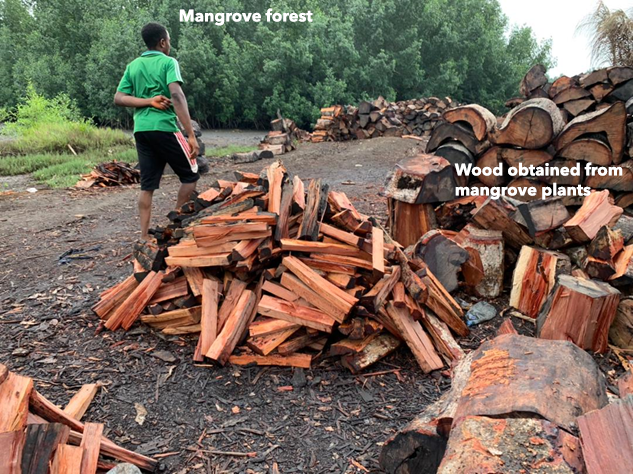- Home
- Publications
- PAGES Magazine
- West African Paleoclimate Reconstruction From Estuary Mangrove Sediments
West African paleoclimate reconstruction from estuary mangrove sediments
Ekoko Eric B
Past Global Changes Magazine
30(2)
118
2022
Bokanda Ekoko Eric
As one of the first PAGES Inter-Africa Mobility Research Fellows, Dr. Bokanda Ekoko Eric, from Cameroon, spent a month (11 April – 12 May 2022) at the Botswana International University of Science and Technology, where he had the opportunity to conduct measurements in the lab on mangrove sediments.
Mangroves are mostly associated with muddy, tropical deltas, and may also grow on substrates such as sand, volcanic lava, and carbonates. Within mangrove environments, there are sediments which are formed in situ (autochthonous sediments). Other (allochthonous) sediments may be transported to this environment or catchment through fluvial discharge, tidal current input, or littoral drift. The allochthonous and autochthonous sediments within these zones are powerful paleoclimate proxies.
Waterlogged and anoxic conditions, which hinder microbial degradation of organic materials, are common in below-ground carbon reservoirs. As such, carbon in blue carbon zone sediments (i.e. carbon stored in coastal and marine ecosystems) can remain buried for millennia if the sediments remain undisturbed, making them important long-term carbon sinks. Mangroves are known to be one of the most important blue carbon ecosystems, storing large amounts of carbon. According to Nyanga (2020), mangroves are able to store and stock large quantities of carbon from the atmosphere during their growing periods from 50 metric tons to as much as 220 metric tons per acre. The long-term carbon storage or sequestration per unit area is substantially higher within mangrove ecosystems than other coastal or marine ecosystems, thus playing a vital role in mitigating climate change impacts (Alongi et al. 2016).
The Tiko coastal areas harbor mangrove forests that are currently being destroyed by anthropogenic activities. Due to the low standard of living and poverty, many Indigenous people within these localities have engaged in activities such as boat making and wood sales (Fig. 1). The majority of the population uses these mangroves to construct small houses and villages, which lie directly above small creeks that are flooded during high tide.
Scientific objective and activities
The objective of this project is to determine the paleoclimatic and paleoenvironmental changes that have taken place over the last 10,000 years in this region. Since these areas act as sinks for allochthonous sediments, we will also evaluate the heavy metals found within these sediments in order to evaluate how human activities and heavy-metal contamination may affect the mangrove ecology. This work will be completed in three phases.
Phase I: This phase includes field work in which we visited the mangrove areas to collect cores of ca. 1-1.5 m using a PVC tube. The cores from the two sites have already been collected. The dark and sticky nature of the cores indicate abundant organic matter and the presence of clay minerals. The color variations also show there may be significant climate variations within these areas and also an environmental shift as we move up the cores.
 |
|
Figure 1: The Tiko Mangroves. The area shown here was covered entirely by mangroves, but the region has been deforested for fossil fuels and the construction of houses and fishing boats. |
Phase II: This phase includes the laboratory work, where grain-size analyses, mineralogy, geochemistry, total organic carbon, stable isotopes of carbon and oxygen and carbon-14 dating will be performed. The first results from granulometry analyses show that most of the samples studied from the different layers are silty, silty clay, and clays. Regarding the mineralogy, preliminary results indicate the presence of clay minerals such as kaolinite, smectite, illite, and montmorillonite, as well as non-clay minerals such as quartz. The geochemistry shows high proportions of silica compared to other elements. The CaCO3 proportion in a few of the samples is at least 2%, which is far greater than most sediments obtained from lakes.
Phase III: This phase comprises the interpretation of the results, which is ongoing. With the results, we should be able to determine the amount of carbon stored in the sediments, determine the climatic and environmental variations as a function in time, and assess the effects of humans and, specifically, heavy metals which may either be natural or anthropogenic on the climate in these areas.
affiliation
Department of Geology, University of Buea, Cameroon
contact
Bokanda Ekoko Eric: eric_ekoko yahoo.com
yahoo.com
references